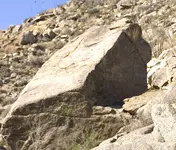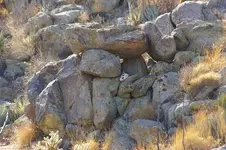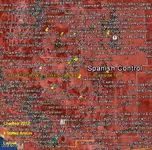gollum
Gold Member
- Joined
- Jan 2, 2006
- Messages
- 6,770
- Reaction score
- 7,734
- Golden Thread
- 0
- Location
- Arizona Vagrant
- Detector(s) used
- Minelab SD2200D (Modded)/ Whites GMT 24k / Fisher FX-3 / Fisher Gold Bug II / Fisher Gemini / Schiebel MIMID / Falcon MD-20
- Primary Interest:
- All Treasure Hunting
- #1
Thread Owner
Okay,
So here we go. I started exploring this area several years ago based on a well known history of Spanish presence for hundreds of years. At the mouth of a particular canyon, there was a large boulder. Once I had sat back and stared at it until I started getting hungry (and a little cross-eyed), a theory as to its' meaning started coming to me.

Look carefully, and see the arrow pointing up to where there is the top half of a heart (the bottom is hidden). After a lot of contemplation (this is where I was shooting from the hip based on what I knew about symbols and monuments), I came to believe that the monument indicated to follow the arrow along the trail (it pointed the way), and it would eventually lead to hidden gold. Let me explain why I thought this: Heart=Gold. The bottom point of a heart typically indicates the spot to dig. Since the dig pointer was hidden, I assumed it meant that the place to dig for gold was hidden.
............... or it could mean that somewhere up the canyon lived a tribe of large breasted women!


About a mile up the canyon (high up on one side) was a very evident number "7". The number "7" on a trail (according to Kenworthy) indicated a protected campsite. Around the back of the rock formation was a very well protected site. Digging at the site produced a good bit of old charcoal.

Further up the trail, high on a ridge, was what is called a "balanced pointer". It is a man placed rock, about seven feet on the side, four feet across the back, and a couple of feet thick. It points to a saddle in the ridge which leads to the only year round water source in the area.

----------------------------------------- ------------------------------

Another mile or so up the canyon (again high on a ridge) is a very beautiful, and well made bird monument.

Look carefully, and you will see that this bird is made from four separate rocks (none from that particular outcropping); The body, neck, counterbalance for the head, and the head with beak.
According to Kenworthy, a bird monument directs the hunter to go in the direction the beak is pointing, but keep an eye out as a change of direction will be coming up. In this case, the beak is guiding us in the same direction we are already traveling.
A ways further up the canyon, off to one side, was a box canyon. In the middle of this box canyon there is an outcropping of very dark lava rock. In the middle of this outcropping, a chunk of the dark rock was removed, and in it's place a large piece of white bull quartz was inserted. This is what Kenworthy called an "eye catcher". It is well named. Mother Nature did not place that rock there.

When I got up close to the "eye catcher" I noticed what looked like a place to stand in front of the rock.

Standing in that spot, I began searching the sides of the canyon walls and ridgelines. Eventually, I saw a large rockfall of uniform gray boulders. In the middle of this rockfall, I saw another large chunk of white bull quartz. Again, not the work of mother nature.

Also, notice how many of the rocks in this "natural" rockfall seem to be nicely fitted together.

Now, there are some more monuments, and no, I won't show whether there was or was not anything at the end of the trail. Don't PM me for any details. I tell you now that I won't reply. This exercise was strictly to show that Chuck A. Kenworthy did not make up the monuments, symbols, and signs he included in his books. I will say that he did not include ALL the monuments, symbols, and signs he knew about, but the ones he did include were based on factual evidence.
Best - Mike
So here we go. I started exploring this area several years ago based on a well known history of Spanish presence for hundreds of years. At the mouth of a particular canyon, there was a large boulder. Once I had sat back and stared at it until I started getting hungry (and a little cross-eyed), a theory as to its' meaning started coming to me.

Look carefully, and see the arrow pointing up to where there is the top half of a heart (the bottom is hidden). After a lot of contemplation (this is where I was shooting from the hip based on what I knew about symbols and monuments), I came to believe that the monument indicated to follow the arrow along the trail (it pointed the way), and it would eventually lead to hidden gold. Let me explain why I thought this: Heart=Gold. The bottom point of a heart typically indicates the spot to dig. Since the dig pointer was hidden, I assumed it meant that the place to dig for gold was hidden.
............... or it could mean that somewhere up the canyon lived a tribe of large breasted women!



About a mile up the canyon (high up on one side) was a very evident number "7". The number "7" on a trail (according to Kenworthy) indicated a protected campsite. Around the back of the rock formation was a very well protected site. Digging at the site produced a good bit of old charcoal.

Further up the trail, high on a ridge, was what is called a "balanced pointer". It is a man placed rock, about seven feet on the side, four feet across the back, and a couple of feet thick. It points to a saddle in the ridge which leads to the only year round water source in the area.

----------------------------------------- ------------------------------

Another mile or so up the canyon (again high on a ridge) is a very beautiful, and well made bird monument.

Look carefully, and you will see that this bird is made from four separate rocks (none from that particular outcropping); The body, neck, counterbalance for the head, and the head with beak.
According to Kenworthy, a bird monument directs the hunter to go in the direction the beak is pointing, but keep an eye out as a change of direction will be coming up. In this case, the beak is guiding us in the same direction we are already traveling.
A ways further up the canyon, off to one side, was a box canyon. In the middle of this box canyon there is an outcropping of very dark lava rock. In the middle of this outcropping, a chunk of the dark rock was removed, and in it's place a large piece of white bull quartz was inserted. This is what Kenworthy called an "eye catcher". It is well named. Mother Nature did not place that rock there.

When I got up close to the "eye catcher" I noticed what looked like a place to stand in front of the rock.

Standing in that spot, I began searching the sides of the canyon walls and ridgelines. Eventually, I saw a large rockfall of uniform gray boulders. In the middle of this rockfall, I saw another large chunk of white bull quartz. Again, not the work of mother nature.

Also, notice how many of the rocks in this "natural" rockfall seem to be nicely fitted together.

Now, there are some more monuments, and no, I won't show whether there was or was not anything at the end of the trail. Don't PM me for any details. I tell you now that I won't reply. This exercise was strictly to show that Chuck A. Kenworthy did not make up the monuments, symbols, and signs he included in his books. I will say that he did not include ALL the monuments, symbols, and signs he knew about, but the ones he did include were based on factual evidence.
Best - Mike
Last edited:





